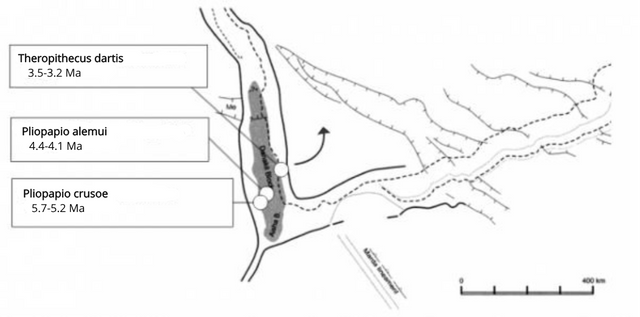Pliopapio alemui found at the 4.4 million year old Aramis localities show more adaptation to terrestrial locomotion than colobines, but less than that seen in extant Theropithecus, (Grine, F.E., 2011) supporting the idea that they are ancestral to Theropithecus dartis found at the 3.3-3.5 million year old localities Hadar. Four isolated papionin teeth from 5.7-5.2 Ma at the Adu-Asa Formation (Grine, F.E., 2011) are similar in size and morphology to the P. alemui material from the Aramis and Kuseralee Members, and could represent an ancestral species, tentatively classified as Pliopapio crusoe, having been isolated on Danakil where the coastal grasslands supported the evolution towards grass-eating papionin.

Synapses
White, T. D., Ambrose, S. H., Suwa, G., Su, D. F., DeGusta, D., Bernor, R. L., … Vrba, E. (2009). Macrovertebrate Paleontology and the Pliocene Habitat of Ardipithecus ramidus. Science, 326(5949), 67–67, 87–93. https://doi.org/10.1126/science.1175822
Grine, F. E. (2011). Ardipithecus kadabba: Late Miocene Evidence from the Middle Awash, Ethiopia. The Middle Awash Series, Volume 2. Edited by Yohannes Haile‐Selassie and Giday WoldeGabriel. Berkeley (California): University of California. ISBN: 978‐0‐520‐25440‐4. 2009. The Quarterly Review of Biology, 86(2), 125–126. https://doi.org/10.1086/659893